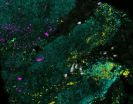The ghosts are whitebark pine forests that have been devastated by mountain pine beetles and white pine blister rust, said the Montana State University scientist who studies fungi that grow in extreme environments. The skeletons are dead trees that no longer shade snow or produce pine cones. The round purple pine cones hold the seeds that feed bears, red squirrels and Clark's nutcracker birds. Shade at the top of watersheds keeps snow from melting too fast in the spring, preventing trout streams from drying up too early in the summer.
Fortunately, she has found hope in a native fungus called Siberian slippery jack, or Suillus sibiricus, said Cripps, a mycologist in MSU's Department of Plant Sciences and Plant Pathology.
Cripps conducted a three-year study in collaboration with Waterton Lakes National Park in Canada that showed a 10 to 15 percent increase in the survival rate of whitebark pine seedlings when Siberian slippery jack spores are injected into the soil around them. The injection takes place in nurseries before the seedlings are transplanted in the mountains.
That increase is significant and good news for those trying to reinstate whitebark pine trees to the north-central Rocky Mountains and Pacific Northwest, Cripps said. The whitebark pine is a keystone species that grows at high elevations where other trees cannot, but it has been declared an endangered species in Canada and awaits the designation in the United States.
"That (jump in survival rates) might not sound like a big difference, but a small amount is a big deal considering the labor-intensive process," Cripps said. Cyndi Smith, scientist emeritus at Waterton, said "The positive results have encouraged Waterton Lakes National Park to continue inoculating both whitebark and limber pine seedlings, to give them the best opportunity we can to establish and survive to maturity."
Participants in the research project, in addition to Cripps' and Smith's teams, were the U.S. Forest Service, National Park Service and volunteers from the United States and Canada.
Explaining how the collaboration began, Smith said, "Cathy gave a presentation on some of her Yellowstone work at the annual science meeting of the Whitebark Pine Ecosystem Foundation in Hailey, Idaho, in 2006. I was really taken with the idea that the ecosystem may have lost the beneficial fungi because our forests have been dead and dying for so long and that perhaps there was a way to reverse that trend so I approached Cathy with the idea.
"I'm a big believer in collaboration, whether locally or internationally, but certainly working with someone of Cathy's academic stature has been very helpful when I have applied for funding for whitebark and limber pine projects," Smith said, adding that, "Cathy's enthusiasm is very infectious, and it is a delight to work with her."
To carry out the research project, the participants placed cages around whitebark pine trees to collect pine cones without interference from wildlife. Then they tested the cones to see if they were resistant to white pine blister rust, removed seeds by hand from the resistant cones, grew the seeds into seedlings and shipped them to the nursery in Glacier National Park. Cripps and former graduate student Erin Lonergan drove to Waterton Lakes National Park and throughout the Greater Yellowstone area, hiked to the tops of mountains and collected the Siberian slippery jack and other fungi from whitebark pine forests. Then they returned to MSU where they used a coffee grinder to process the spongy outer layer of the fungi. They added water to create a spore slurry, stored the mixture at MSU and later injected about 3 million spores into the soil around each seedling temporarily housed at the Glacier National Park nursery.
A few months later, volunteers planted more than 1,000 seedlings into MSU's test plots. Most of those test plots were located in Waterton, while others were in the neighboring Glacier National Park. The two parks together comprise Waterton-Glacier International Peace Park.
Two years into the study, Lonergan, Cripps and Smith reported success in the journal, American Forests. One year later, they announced their final results in the spring/summer 2014 issue of Nutcracker Notes, a small journal hosted by the Whitebark Pine Ecosystem Foundation.
"We wanted to get the word out that results after three years showed that inoculation with these native fungi significantly improved the survival of rust resistant seedlings, especially when inoculated seedlings were planted in burned areas near shelter objects such as stumps and logs," Cripps said.
High nitrogen fertilizations and fungicides prevent the inoculations from working, Cripps said. The age of the seedlings is important because they need to grow plenty of side roots before being inoculated. When successful, the injected fungi slip like tiny socks over the ends of every root of the whitebark pine seedling and form a relationship that benefits both the tree and the fungi, Cripps said. The fungi help the seedling take in more nutrients and water from the soil. The tree produces the sugars that feed the fungi.
"Instead of being bad guys, these fungi are beneficial," Cripps said of the Siberian slippery jack. "They help plants take up nitrogen and phosphorous from the soil. That's a big deal." Her study is one of many research projects involving whitebark pine forests, but it's unique because it focuses on beneficial native fungi, Cripps said. She added that land managers might want to incorporate MSU's findings into their overall strategy for restoring whitebark pine forests. She noted that large-scale inoculations are already planned for nurseries in Canada. She said inoculating beneficial fungi into nursery stock is common in Europe.
"As we work to save the vital whitebark pine from disappearing from the landscape, it is essential to use all available tools," Cripps said. "Ectomycorrhizal fungi are an integral part of forest integrity, ecology and health. Showing respect for these mighty microbes might just mean the difference between the restoration and death of a forest."
"Ectomycorrhizal fungi" refers to beneficial fungi that form a symbiotic relationship with the roots of trees. Siberian slippery jack is one of those fungi, and it only associates with five-needle pines. White pine blister rust is another type of fungus, one of the "bad guys."
INFORMATION:
Cripps, Lonergan and MSU postdoctoral researcher Eva Grimme discovered previously that the Siberian slippery jack that lives in the stone pine forests of Europe and Asia also lives with five-needle pines in western North America. In fact, it lives in most of the whitebark pine forests they studied from the Greater Yellowstone area to Alberta.
For more information, go to http://www.americanforests.org/our-programs/endangered-western-forests/underground-connection-fungi-and-pines-in-peril/




